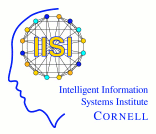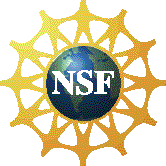NESCAI08: The Third North East Student Colloquium on Artificial Intelligence
2-4 May 2008, Ithaca, NY
|
Invited Talks
Only connect! Explorations in graph-based approaches to
information retrieval and natural-language processing
- Abstract:
-
Can we create a system that can learn to understand
political speeches well enough to determine the speakers' viewpoints?
Can we improve information retrieval by using link analysis, as is
famously done in Web search, if we are dealing with documents that
don't contain hyperlinks? And how can these two questions form the
basis of a coherent talk? Answer: graphs!
- Bio:
- Lillian Lee is an associate professor in the Computer Science
Department of Cornell University. She is the recipient of the Best
Paper Award at HLT-NAACL 2004 (joint with Regina Barzilay), a citation
in "Top Picks: Technology Research Advances of 2004" by Technology
Research News, and an Alfred P. Sloan Foundation Fellowship. But she
is not from Iowa; nor is she ranked 843; and she is certainly not the
pine-scented air.
Powers of Two: Alignment and Agreement between Models and Modalities
- Abstract:
-
Problems of alignment or correspondence of different types of objects
are predominant in many fields: phrase alignment for machine
translation, matching of images/video and text, etc. In these tasks,
the similarity between two corresponding elements is difficult to
specify and tune by hand, since it involves elements of different
types: words of
different languages, faces and names, image regions and words. I will
describe approaches to supervised and weakly supervised alignment
learning that exploit the power of agreement between two models or two
modalities.
- Bio:
-
Ben Taskar received his bachelor's and doctoral degree in Computer
Science from Stanford University. After a postdoc at the University of
California at Berkeley, he joined the faculty at the University of
Pennsylvania Computer and Information Science Department in 2007. His
research interests include machine learning, graphical models,
large-scale and distributed convex optimization, applications in
natural language processing, computer vision, and computational
biology. His work on structured prediction has received awards at NIPS
and EMNLP conferences.
|



